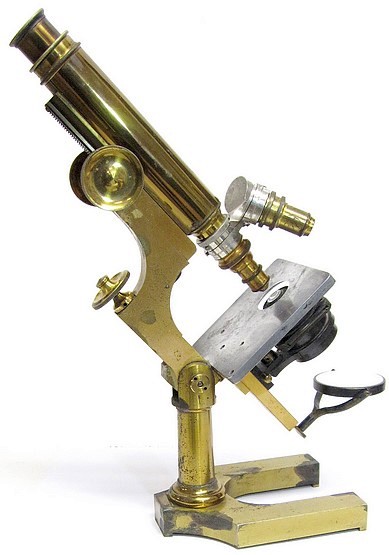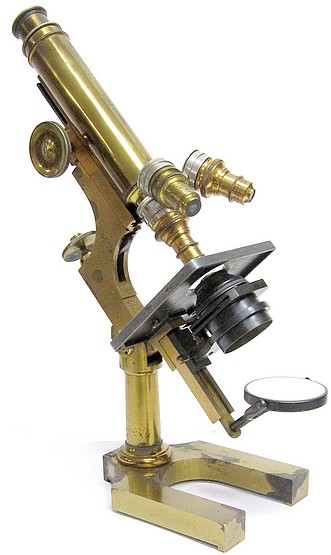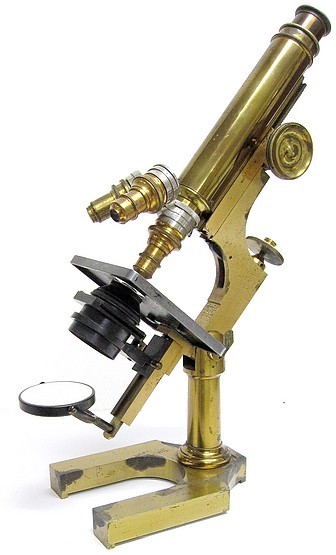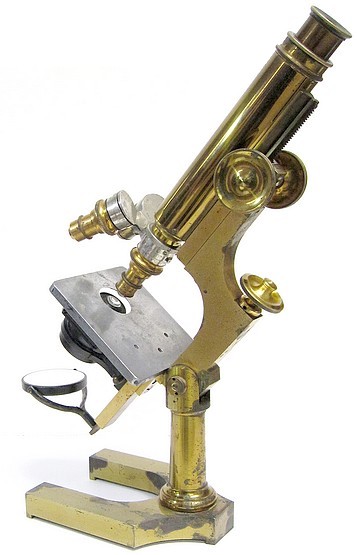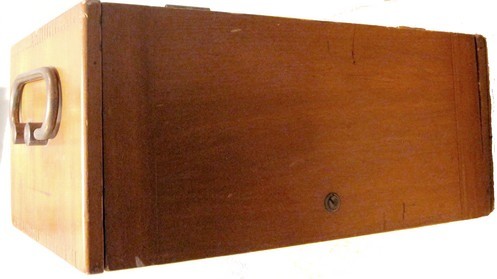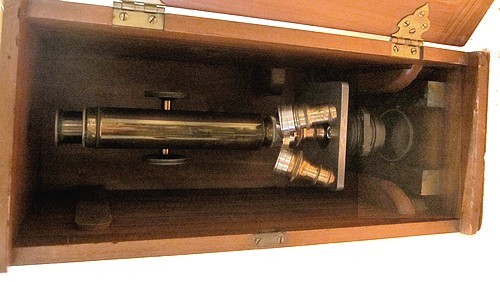While this microscope is
unsigned, it is clearly an example of Zentmayer's
American Continental Stand V. This model, introduced at
the end of the 19th century, was the last that the
Zentmayer firm produced. It was made in order to capitalize
on the popularity of the "Continental" style
microscopes that were being offered by most of the
other firms in the US and abroad. Nevertheless, this
model still incorporated the lever fine adjustment
mechanism that was used in Zentmayer's American style
microscopes. The microscope is supplied with two
objectives marked Griffith Fairport NY, a 1/5 and
2/3-inch, and an objective marked Spencer Lens Co.
Student, 1-inch. The sub-stage consists of an
Abbe condenser and double sided mirror. Unique among
Zentmayer microscopes, this model is suppled with an
aluminum stage.
The following was taken from the 1895 Zentmayer Catalog of Microscopes:
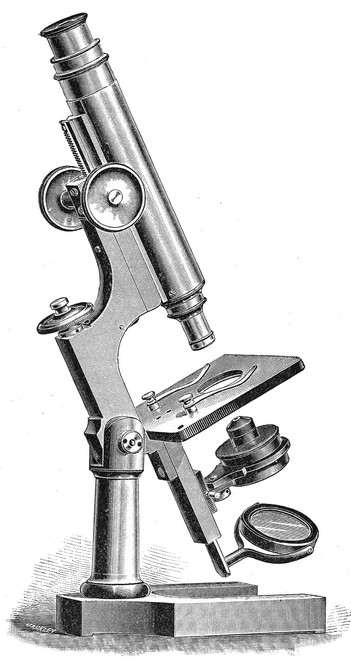
AMERICAN-CONTINENTAL STAND
This Stand has been
designed to meet the wants of those workers who prefer
the Continental model. It is substantially a
combination of the upper half of our celebrated
American Stands with the lower half of the best
Continental Stands, and is adapted to have added all
the usual optical accessories of either class of
Microscopes.
The Stand is constructed
entirely of brass, handsomely finished and polished.
The base is of horse-shoe form, filled with lead for
extra weight, and gives perfect steadiness in every
position. A stout pillar firmly supports the arm of the
instrument on a trunnion-joint, which allows all
inclinations from the perpendicular to the horizontal
position. The coarse and fine adjustments are of the
same style and construction as previously described.
The body and draw-tube give both English and
Continental standards, accommodating objectives
corrected for either length. The spacious stage is made
of aluminum, which is incorrodible; the dimensions
(three and live-eighths inches square) are
commodious even for culture slides or serial sections;
the surface is plane, with recessed opening to receive
a plate-glass, light-modifier, or disk-diaphragm, if
wanted; removable clips are provided, with springs
shaped and adjusted to hold a slide and yet allow easy
movement about the field of view. The sub-stage has
long sliding movements in the fixed bar beneath the
stage, allowing ample room for a condenser or
polarizer, and exact adjustments are easily and quickly
made by aid of milled knobs extending on each side of
the sliding bracket, on which the ring of the sub-stage
is centered and affixed instantly by means of a single
set-screw with capstan head. The mirrors. are plane and
concave, of large size, and have complete adjustments
on an extensible bar. The diaphragms are cone-shaped,
and have three different sizes of apertures. The Abbe
illuminating apparatus has a condenser of 1.20 N. A.
and Iris diaphragm with complete movements. A condenser
of 1.40 N. A. can be substituted, if preferred, for the
difference in the cost of the condensing systems. A set
of stops are also furnished for dark-ground
illumination.
The Stand can be
furnished with a swinging sub-stage, with or without
rack and pinion movement, and with a circular centering
and revolving stage, provided with a sliding carriage
similar to the Centennial Stand, at an additional
moderate expenditure, and it is well worthy of such
conveniences.
A modification of the
swinging sub-stage and mirrors can also be furnished,
whereby the extensible mirror-bar slides in another bar
which swings from a joint on the under side of the
swinging-bar carrying the sub-stage. This construction
allows the sub-stage and mirrors to swing independently
of each other, click-stops indicating when either or
both bars are in the optic axis of the instrument, and
permits the sub-stage to be swung aside entirely and
the mirrors, alone to be then swung into positions for
central or oblique illumination, without interference
from the sub-stage. The mirrors can be likewise swung
aside completely to permit the use of direct
illumination, with or without sub-stage apparatus.
These movements contribute much to convenient and rapid
use, as it is unnecessary to remove and afterward
return the sub-stage, or mirrors, or any other part. In
this instance the stage is made somewhat narrower to
allow the sub-stage to swing clear aside.
The draw-tube can be
graduated in tenth-inches, or millimeters, or
otherwise, as desired, and the milled head of the fine
adjustment can be likewise graduated to measure
longitudinal movements of the body, thus furnishing
quite exact and very convenient means of gauging the
thickness of cover-glasses or sections at small extra
expense.
19. American-Continental
Stand, Monocular, sliding sub-stage, cone diaphragms,
and adjustable mirror-bar; one Ocular ; 8/16-inch
Objective, 0.23 N. A.; 1/6-inch Objective, 0.61 N. A.
(easily resolving P. angulatum); Abbe Illuminator, 1.20
N. A., with Iris diaphragm; Walnut Case, with drawer
for Accessories,- $55.00
20.
Stand only, with one Ocular and
Case,- $35.00
21.
Stand, with sub-stage movement
by rack and pinion; one Ocular, and
Case,- $44.00
23.
Stand same as No..21, with same
accessories as No. 19, - $64.00
23.
Binocular body, with one
pair of Oculars,- $30.00
